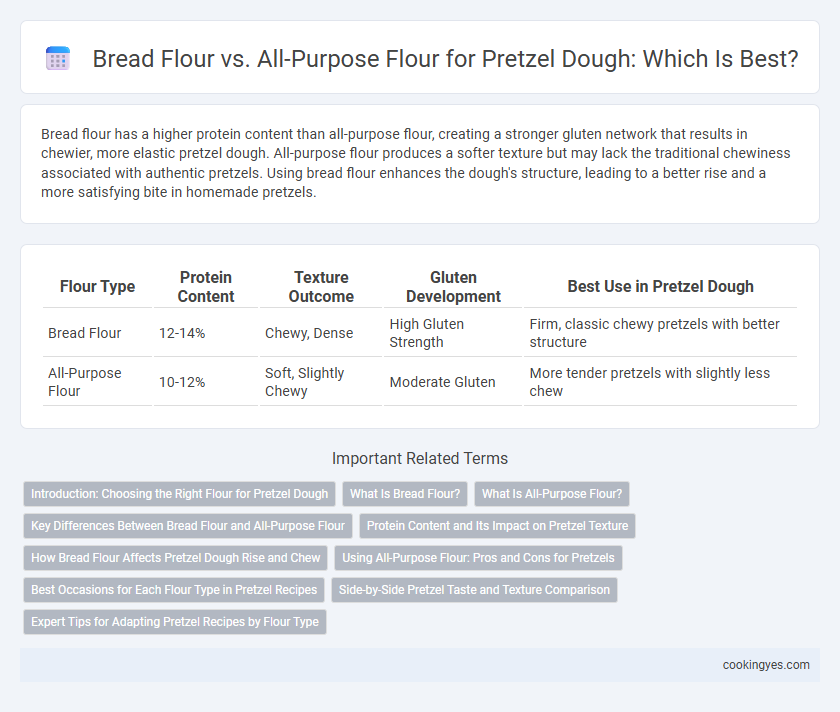Bread flour has a higher protein content than all-purpose flour, creating a stronger gluten network that results in chewier, more elastic pretzel dough. All-purpose flour produces a softer texture but may lack the traditional chewiness associated with authentic pretzels. Using bread flour enhances the dough's structure, leading to a better rise and a more satisfying bite in homemade pretzels.
Table of Comparison
| Flour Type | Protein Content | Texture Outcome | Gluten Development | Best Use in Pretzel Dough |
|---|---|---|---|---|
| Bread Flour | 12-14% | Chewy, Dense | High Gluten Strength | Firm, classic chewy pretzels with better structure |
| All-Purpose Flour | 10-12% | Soft, Slightly Chewy | Moderate Gluten | More tender pretzels with slightly less chew |
Introduction: Choosing the Right Flour for Pretzel Dough
Bread flour's higher protein content, typically around 12-14%, develops more gluten, providing pretzel dough with the necessary elasticity and chewiness characteristic of traditional pretzels. All-purpose flour, with a protein content ranging from 10-12%, yields a softer, less resilient dough but can still produce acceptable results for softer pretzel textures. Selecting bread flour is optimal for authentic, chewy pretzels, while all-purpose flour offers versatility and ease for softer, more tender pretzel variations.
What Is Bread Flour?
Bread flour is a high-protein flour, typically containing 12-14% protein, which enhances gluten development essential for pretzel dough's chewy texture and structure. Its robust gluten network provides elasticity and strength, allowing pretzel dough to hold its shape during boiling and baking. Using bread flour results in pretzels with a crisp crust and a chewy, dense interior compared to all-purpose flour.
What Is All-Purpose Flour?
All-purpose flour is a versatile wheat flour with a moderate protein content, typically around 10-12%, making it suitable for a wide range of baked goods, including pretzels. It provides a balanced gluten structure that results in pretzels with a softer, chewier texture compared to the firmer chew from bread flour. This flour type is widely available and offers consistent results for home cooks aiming to create classic, flavorful pretzels without the dense bite that higher-protein bread flour imparts.
Key Differences Between Bread Flour and All-Purpose Flour
Bread flour contains higher protein content, typically around 12-14%, which promotes stronger gluten development essential for the chewy texture of pretzel dough. All-purpose flour has a moderate protein level, usually 10-12%, resulting in a softer, less elastic dough that may yield pretzels with a lighter, less structured crust. Choosing bread flour provides better elasticity and rise, while all-purpose flour offers a more tender crumb but less robust chew.
Protein Content and Its Impact on Pretzel Texture
Bread flour, with its higher protein content (typically 12-14%), creates more gluten development in pretzel dough, resulting in a chewier and denser texture ideal for traditional soft pretzels. All-purpose flour, containing around 10-12% protein, produces a softer, less elastic dough that yields a lighter pretzel with a tender crumb but less structural integrity. The protein level directly affects the dough's elasticity and final bite, making bread flour preferable for achieving the classic pretzel chewiness.
How Bread Flour Affects Pretzel Dough Rise and Chew
Bread flour's high protein content, typically around 12-14%, enhances gluten development in pretzel dough, resulting in a stronger, more elastic structure. This increased gluten network traps gases from yeast fermentation more effectively, promoting a superior rise and contributing to the pretzel's characteristic chewy texture. In contrast, all-purpose flour, with lower protein levels, produces a less robust dough that yields a softer crumb and reduced chewiness.
Using All-Purpose Flour: Pros and Cons for Pretzels
Using all-purpose flour for pretzel dough offers greater accessibility and versatility, producing a moderately chewy texture with less gluten development compared to bread flour. Its lower protein content results in softer crusts, which may lack the traditional crunch desired in classic pretzels but enhances tenderness for those preferring a softer bite. However, all-purpose flour can lead to less rise and structural integrity, potentially affecting the pretzel's shape and distinct chewy exterior.
Best Occasions for Each Flour Type in Pretzel Recipes
Bread flour is ideal for pretzel dough when aiming for a chewy texture and a strong gluten network, perfect for traditional soft pretzels enjoyed at fairs or Oktoberfest celebrations. All-purpose flour suits pretzel recipes requiring a tender crumb and slightly less chew, making it a great choice for homemade pretzels or smaller batches meant for everyday snacking. Selecting bread flour enhances the dough's elasticity and rise, while all-purpose flour offers versatility and ease of handling for amateur bakers.
Side-by-Side Pretzel Taste and Texture Comparison
Bread flour, with its higher protein content (12-14%), creates pretzels with a chewier texture and more pronounced structure compared to all-purpose flour, which has a protein content of around 10-12%. Pretzels made from bread flour tend to have a richer, more robust crust and better rise, resulting in a traditional, authentically dense bite. In contrast, all-purpose flour yields a softer, less elastic dough, producing pretzels with a lighter crumb and a slightly tender mouthfeel.
Expert Tips for Adapting Pretzel Recipes by Flour Type
Bread flour enhances pretzel dough by providing higher gluten content, resulting in chewier texture and better shape retention, ideal for traditional soft pretzels. All-purpose flour offers a more tender crumb and slightly lighter bite, making it suitable for softer pretzel variations or baking at home without specialized ingredients. Experts recommend adjusting hydration levels and kneading time based on flour type to achieve optimal dough elasticity and browning during baking.
Bread flour vs all-purpose flour for pretzel dough Infographic

 cookingyes.com
cookingyes.com